Company Accounting Report: AASB Standards and Impairment Analysis
VerifiedAdded on 2022/11/18
|11
|1912
|379
Report
AI Summary
This report provides a detailed analysis of Premier Investments Limited's accounting practices, focusing on its compliance with Australian Accounting Standards (AASBs). The report examines the accounting treatment of brand name assets, their valuation, and the application of AASB 138 for intangible assets. It also explores the impairment of assets, particularly the $30 million write-down of casual brand assets in 2018, and its impact on the company's financial performance. The report discusses the application of AASB 136 regarding impairment and presents an alternative approach involving periodic amortization. The conclusion highlights the importance of true and fair presentation of financial performance and position, suggesting that while Premier Investments Limited complied with accounting standards, the significant write-down influenced the portrayal of the company's financial health. The report references key academic sources to support its findings.
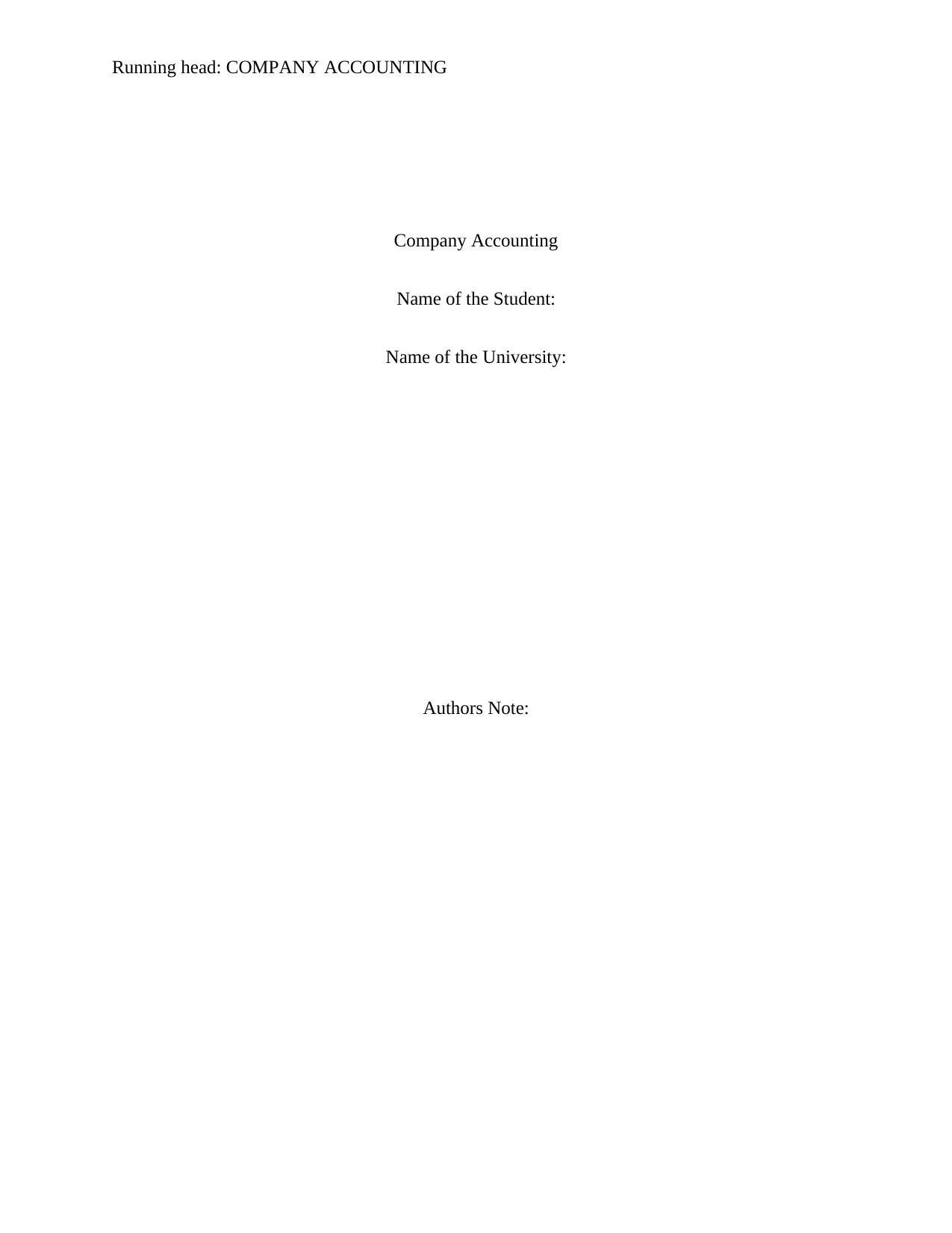
Running head: COMPANY ACCOUNTING
Company Accounting
Name of the Student:
Name of the University:
Authors Note:
Company Accounting
Name of the Student:
Name of the University:
Authors Note:
Paraphrase This Document
Need a fresh take? Get an instant paraphrase of this document with our AI Paraphraser
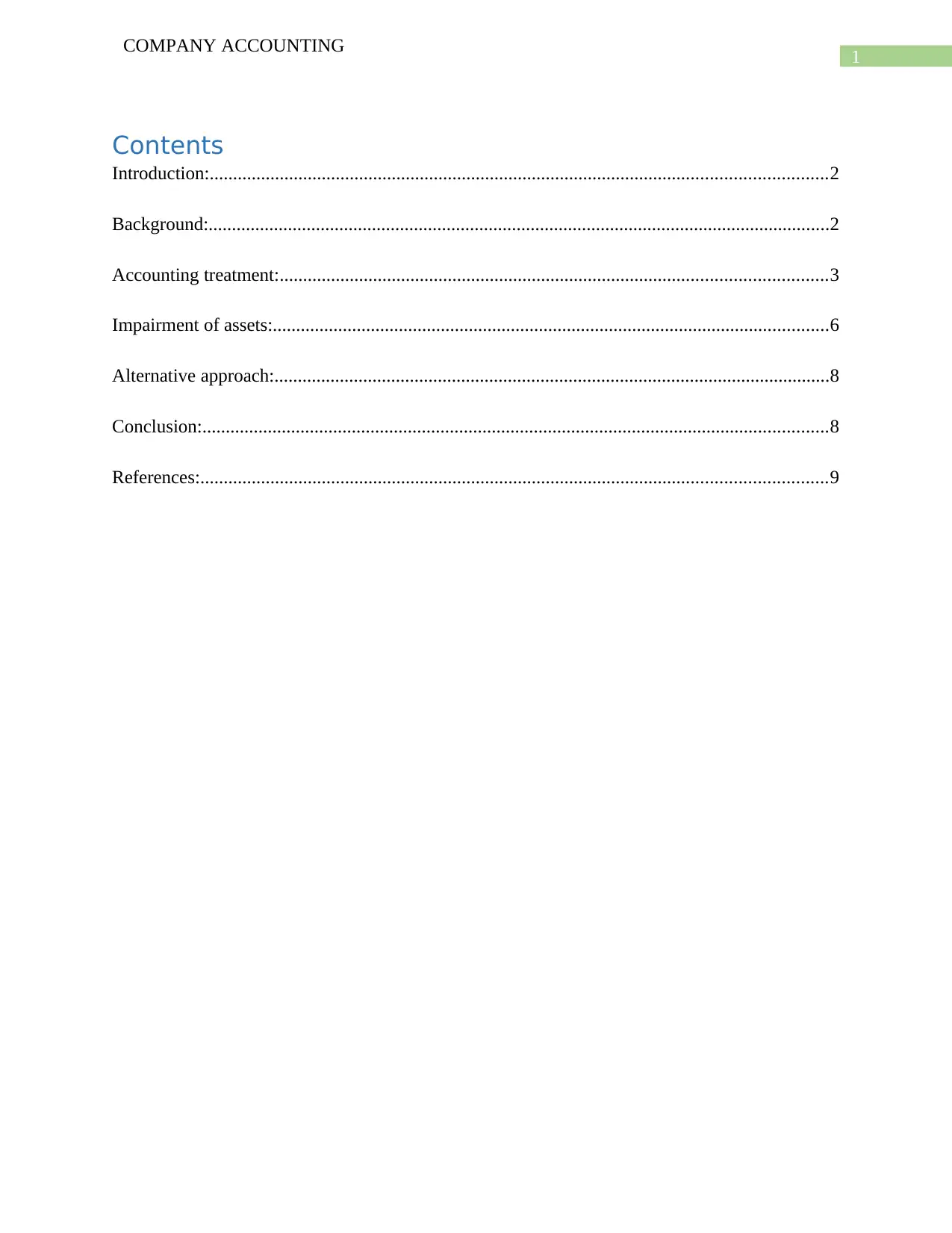
1
COMPANY ACCOUNTING
Contents
Introduction:....................................................................................................................................2
Background:.....................................................................................................................................2
Accounting treatment:.....................................................................................................................3
Impairment of assets:.......................................................................................................................6
Alternative approach:.......................................................................................................................8
Conclusion:......................................................................................................................................8
References:......................................................................................................................................9
COMPANY ACCOUNTING
Contents
Introduction:....................................................................................................................................2
Background:.....................................................................................................................................2
Accounting treatment:.....................................................................................................................3
Impairment of assets:.......................................................................................................................6
Alternative approach:.......................................................................................................................8
Conclusion:......................................................................................................................................8
References:......................................................................................................................................9
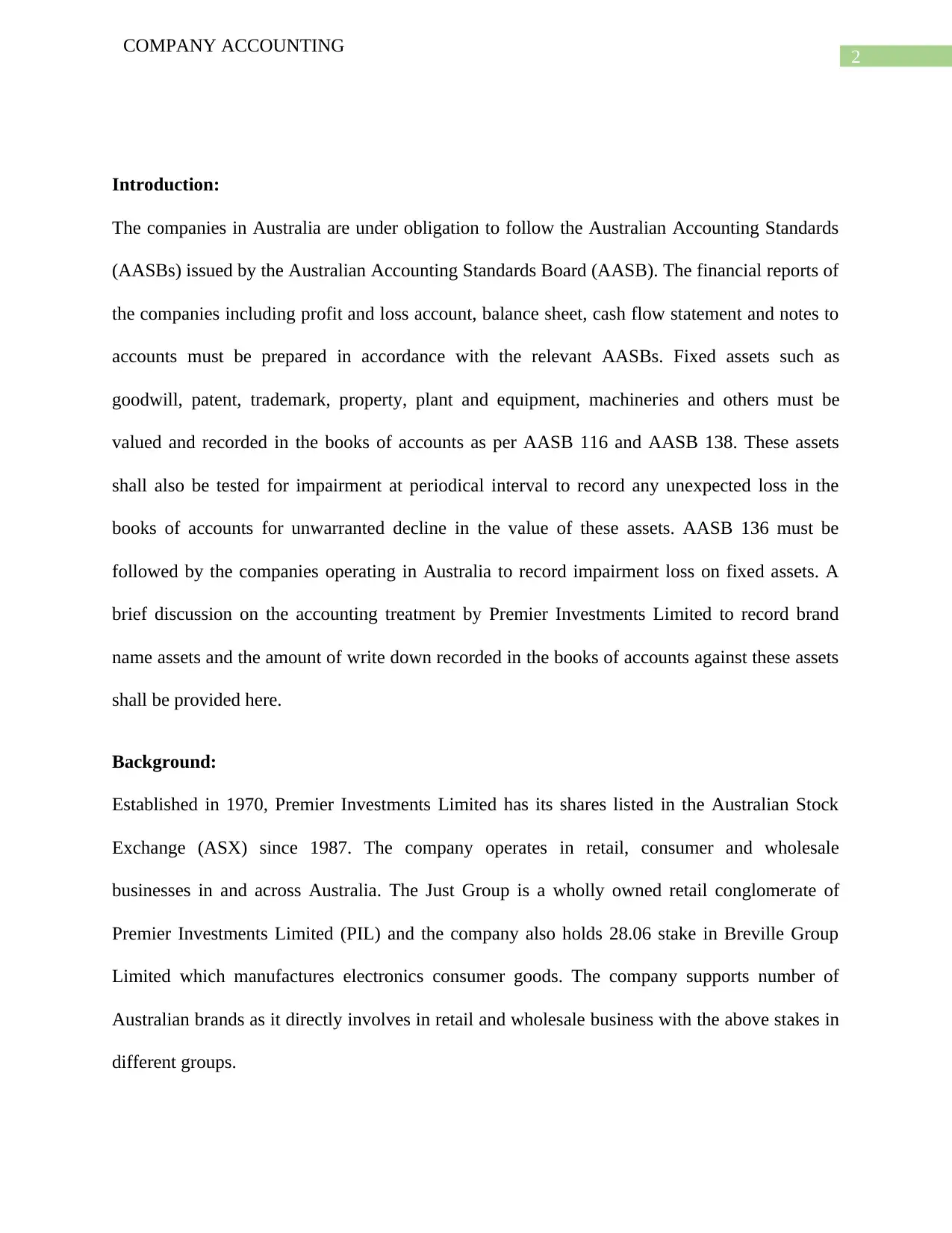
2
COMPANY ACCOUNTING
Introduction:
The companies in Australia are under obligation to follow the Australian Accounting Standards
(AASBs) issued by the Australian Accounting Standards Board (AASB). The financial reports of
the companies including profit and loss account, balance sheet, cash flow statement and notes to
accounts must be prepared in accordance with the relevant AASBs. Fixed assets such as
goodwill, patent, trademark, property, plant and equipment, machineries and others must be
valued and recorded in the books of accounts as per AASB 116 and AASB 138. These assets
shall also be tested for impairment at periodical interval to record any unexpected loss in the
books of accounts for unwarranted decline in the value of these assets. AASB 136 must be
followed by the companies operating in Australia to record impairment loss on fixed assets. A
brief discussion on the accounting treatment by Premier Investments Limited to record brand
name assets and the amount of write down recorded in the books of accounts against these assets
shall be provided here.
Background:
Established in 1970, Premier Investments Limited has its shares listed in the Australian Stock
Exchange (ASX) since 1987. The company operates in retail, consumer and wholesale
businesses in and across Australia. The Just Group is a wholly owned retail conglomerate of
Premier Investments Limited (PIL) and the company also holds 28.06 stake in Breville Group
Limited which manufactures electronics consumer goods. The company supports number of
Australian brands as it directly involves in retail and wholesale business with the above stakes in
different groups.
COMPANY ACCOUNTING
Introduction:
The companies in Australia are under obligation to follow the Australian Accounting Standards
(AASBs) issued by the Australian Accounting Standards Board (AASB). The financial reports of
the companies including profit and loss account, balance sheet, cash flow statement and notes to
accounts must be prepared in accordance with the relevant AASBs. Fixed assets such as
goodwill, patent, trademark, property, plant and equipment, machineries and others must be
valued and recorded in the books of accounts as per AASB 116 and AASB 138. These assets
shall also be tested for impairment at periodical interval to record any unexpected loss in the
books of accounts for unwarranted decline in the value of these assets. AASB 136 must be
followed by the companies operating in Australia to record impairment loss on fixed assets. A
brief discussion on the accounting treatment by Premier Investments Limited to record brand
name assets and the amount of write down recorded in the books of accounts against these assets
shall be provided here.
Background:
Established in 1970, Premier Investments Limited has its shares listed in the Australian Stock
Exchange (ASX) since 1987. The company operates in retail, consumer and wholesale
businesses in and across Australia. The Just Group is a wholly owned retail conglomerate of
Premier Investments Limited (PIL) and the company also holds 28.06 stake in Breville Group
Limited which manufactures electronics consumer goods. The company supports number of
Australian brands as it directly involves in retail and wholesale business with the above stakes in
different groups.
⊘ This is a preview!⊘
Do you want full access?
Subscribe today to unlock all pages.

Trusted by 1+ million students worldwide
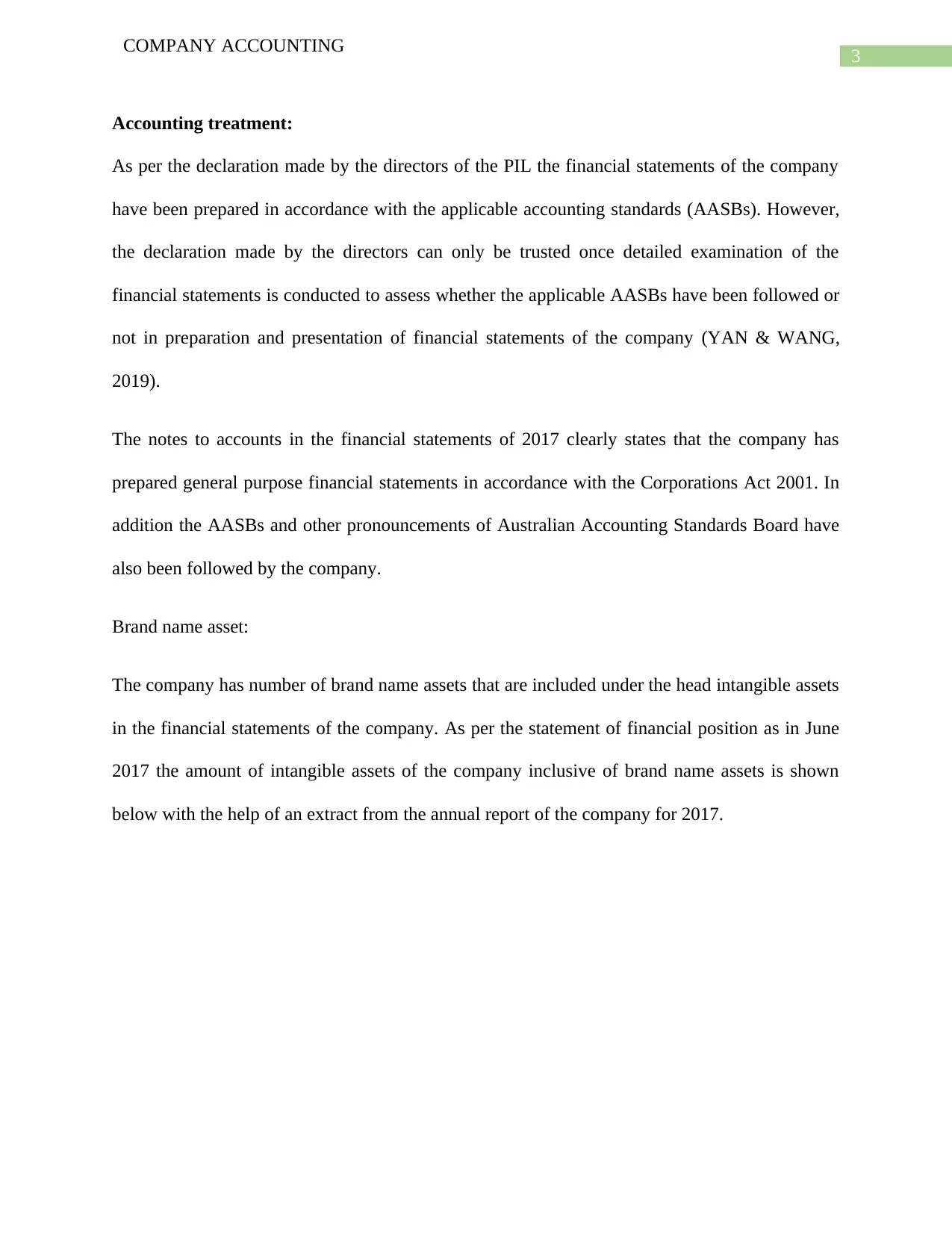
3
COMPANY ACCOUNTING
Accounting treatment:
As per the declaration made by the directors of the PIL the financial statements of the company
have been prepared in accordance with the applicable accounting standards (AASBs). However,
the declaration made by the directors can only be trusted once detailed examination of the
financial statements is conducted to assess whether the applicable AASBs have been followed or
not in preparation and presentation of financial statements of the company (YAN & WANG,
2019).
The notes to accounts in the financial statements of 2017 clearly states that the company has
prepared general purpose financial statements in accordance with the Corporations Act 2001. In
addition the AASBs and other pronouncements of Australian Accounting Standards Board have
also been followed by the company.
Brand name asset:
The company has number of brand name assets that are included under the head intangible assets
in the financial statements of the company. As per the statement of financial position as in June
2017 the amount of intangible assets of the company inclusive of brand name assets is shown
below with the help of an extract from the annual report of the company for 2017.
COMPANY ACCOUNTING
Accounting treatment:
As per the declaration made by the directors of the PIL the financial statements of the company
have been prepared in accordance with the applicable accounting standards (AASBs). However,
the declaration made by the directors can only be trusted once detailed examination of the
financial statements is conducted to assess whether the applicable AASBs have been followed or
not in preparation and presentation of financial statements of the company (YAN & WANG,
2019).
The notes to accounts in the financial statements of 2017 clearly states that the company has
prepared general purpose financial statements in accordance with the Corporations Act 2001. In
addition the AASBs and other pronouncements of Australian Accounting Standards Board have
also been followed by the company.
Brand name asset:
The company has number of brand name assets that are included under the head intangible assets
in the financial statements of the company. As per the statement of financial position as in June
2017 the amount of intangible assets of the company inclusive of brand name assets is shown
below with the help of an extract from the annual report of the company for 2017.
Paraphrase This Document
Need a fresh take? Get an instant paraphrase of this document with our AI Paraphraser
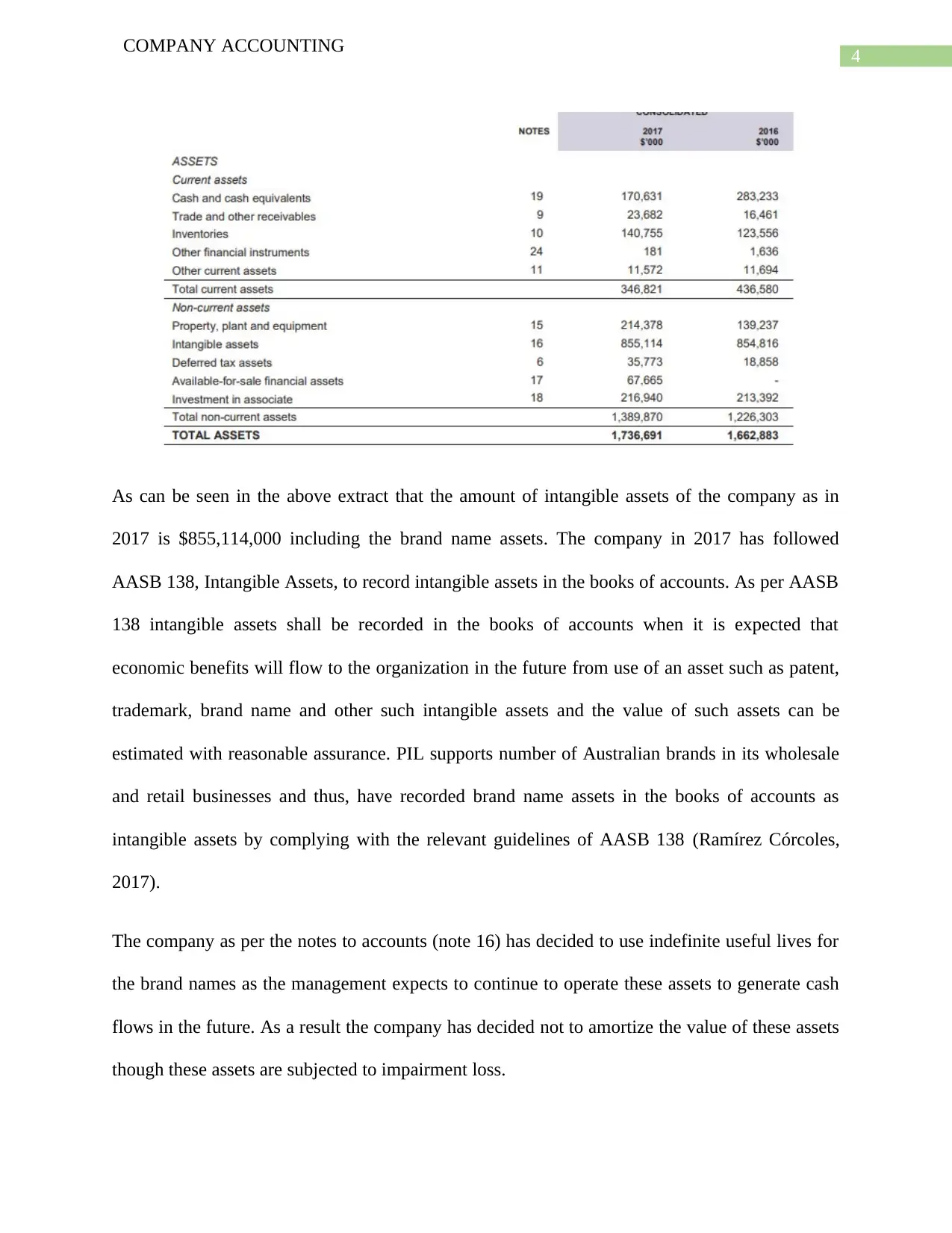
4
COMPANY ACCOUNTING
As can be seen in the above extract that the amount of intangible assets of the company as in
2017 is $855,114,000 including the brand name assets. The company in 2017 has followed
AASB 138, Intangible Assets, to record intangible assets in the books of accounts. As per AASB
138 intangible assets shall be recorded in the books of accounts when it is expected that
economic benefits will flow to the organization in the future from use of an asset such as patent,
trademark, brand name and other such intangible assets and the value of such assets can be
estimated with reasonable assurance. PIL supports number of Australian brands in its wholesale
and retail businesses and thus, have recorded brand name assets in the books of accounts as
intangible assets by complying with the relevant guidelines of AASB 138 (Ramírez Córcoles,
2017).
The company as per the notes to accounts (note 16) has decided to use indefinite useful lives for
the brand names as the management expects to continue to operate these assets to generate cash
flows in the future. As a result the company has decided not to amortize the value of these assets
though these assets are subjected to impairment loss.
COMPANY ACCOUNTING
As can be seen in the above extract that the amount of intangible assets of the company as in
2017 is $855,114,000 including the brand name assets. The company in 2017 has followed
AASB 138, Intangible Assets, to record intangible assets in the books of accounts. As per AASB
138 intangible assets shall be recorded in the books of accounts when it is expected that
economic benefits will flow to the organization in the future from use of an asset such as patent,
trademark, brand name and other such intangible assets and the value of such assets can be
estimated with reasonable assurance. PIL supports number of Australian brands in its wholesale
and retail businesses and thus, have recorded brand name assets in the books of accounts as
intangible assets by complying with the relevant guidelines of AASB 138 (Ramírez Córcoles,
2017).
The company as per the notes to accounts (note 16) has decided to use indefinite useful lives for
the brand names as the management expects to continue to operate these assets to generate cash
flows in the future. As a result the company has decided not to amortize the value of these assets
though these assets are subjected to impairment loss.
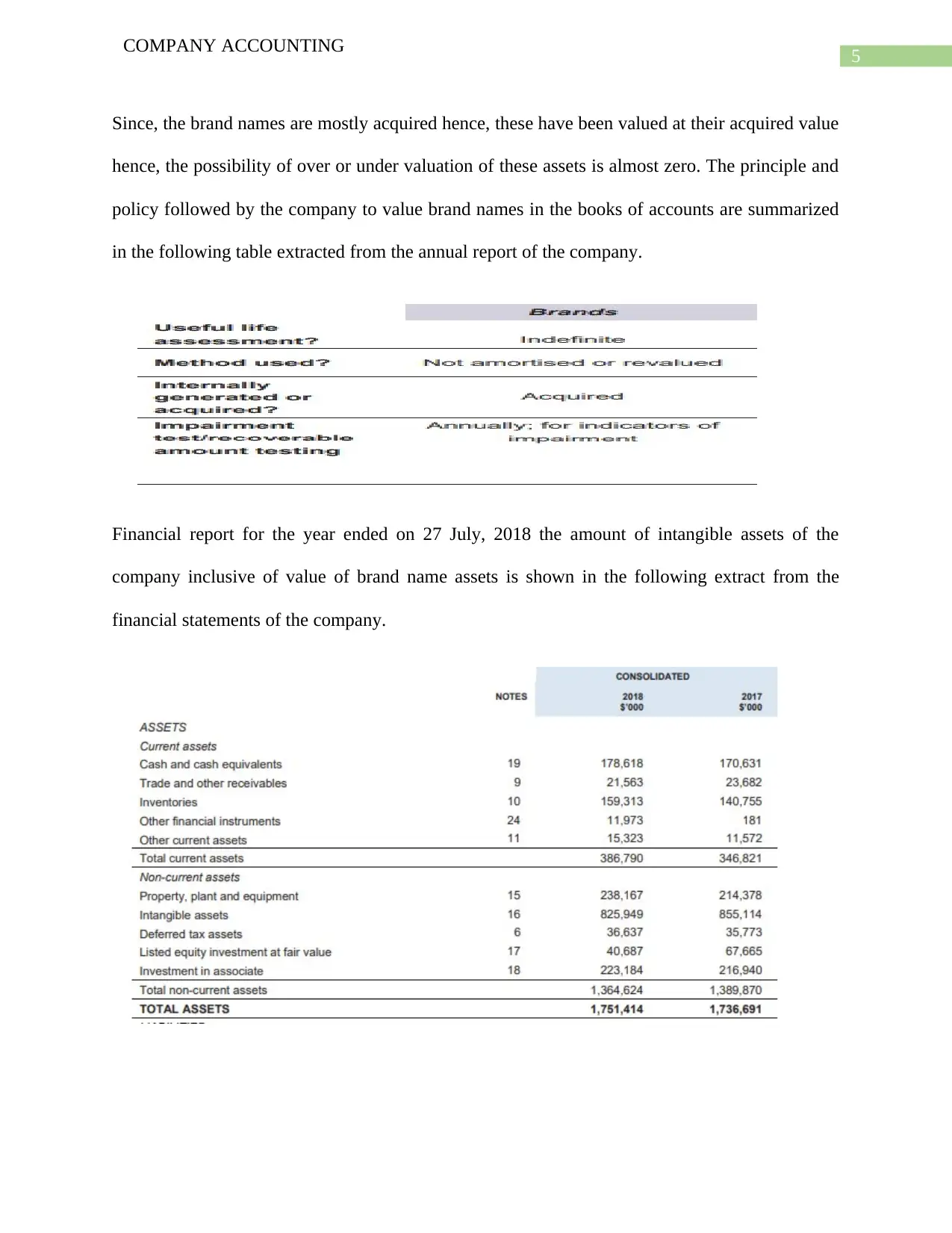
5
COMPANY ACCOUNTING
Since, the brand names are mostly acquired hence, these have been valued at their acquired value
hence, the possibility of over or under valuation of these assets is almost zero. The principle and
policy followed by the company to value brand names in the books of accounts are summarized
in the following table extracted from the annual report of the company.
Financial report for the year ended on 27 July, 2018 the amount of intangible assets of the
company inclusive of value of brand name assets is shown in the following extract from the
financial statements of the company.
COMPANY ACCOUNTING
Since, the brand names are mostly acquired hence, these have been valued at their acquired value
hence, the possibility of over or under valuation of these assets is almost zero. The principle and
policy followed by the company to value brand names in the books of accounts are summarized
in the following table extracted from the annual report of the company.
Financial report for the year ended on 27 July, 2018 the amount of intangible assets of the
company inclusive of value of brand name assets is shown in the following extract from the
financial statements of the company.
⊘ This is a preview!⊘
Do you want full access?
Subscribe today to unlock all pages.

Trusted by 1+ million students worldwide
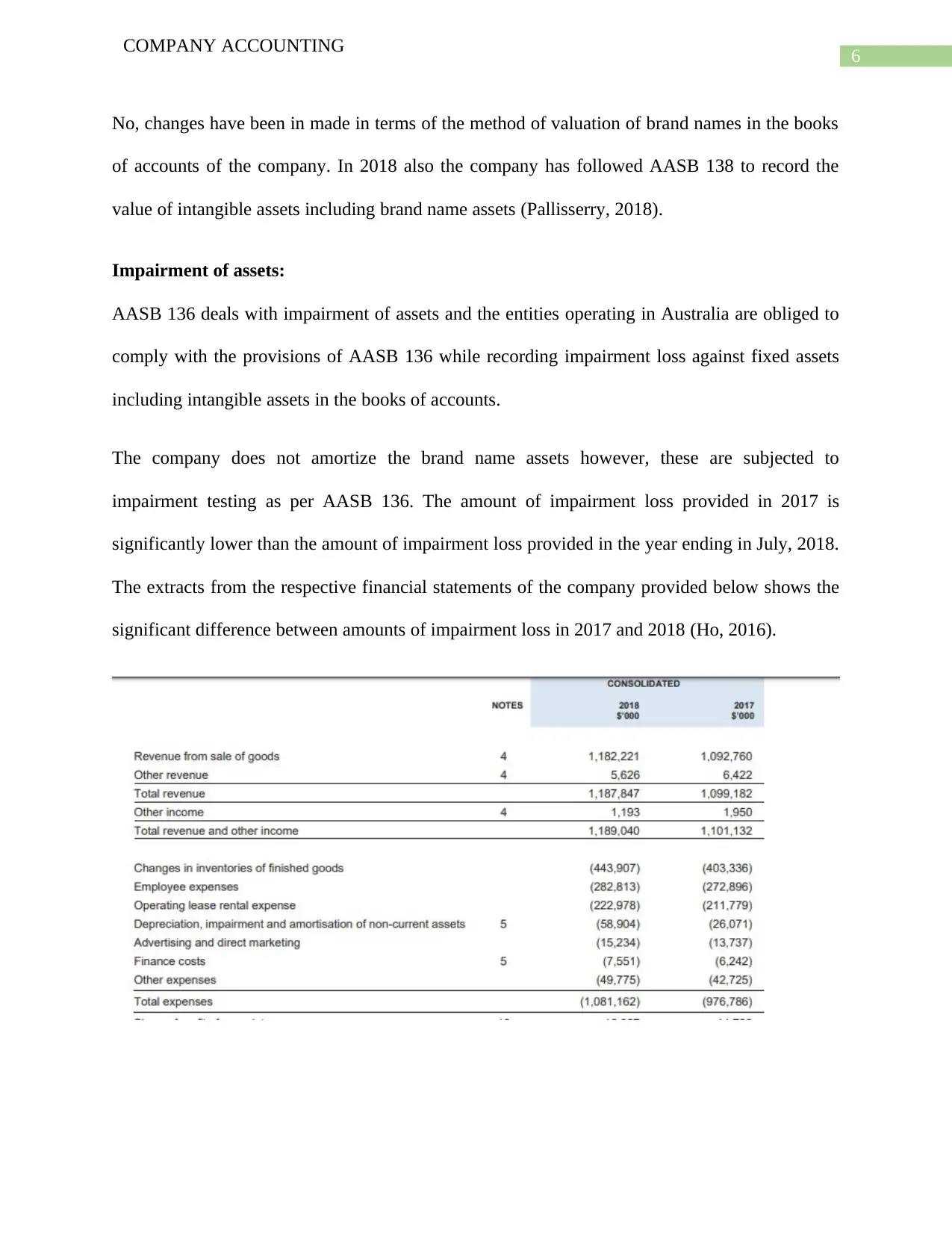
6
COMPANY ACCOUNTING
No, changes have been in made in terms of the method of valuation of brand names in the books
of accounts of the company. In 2018 also the company has followed AASB 138 to record the
value of intangible assets including brand name assets (Pallisserry, 2018).
Impairment of assets:
AASB 136 deals with impairment of assets and the entities operating in Australia are obliged to
comply with the provisions of AASB 136 while recording impairment loss against fixed assets
including intangible assets in the books of accounts.
The company does not amortize the brand name assets however, these are subjected to
impairment testing as per AASB 136. The amount of impairment loss provided in 2017 is
significantly lower than the amount of impairment loss provided in the year ending in July, 2018.
The extracts from the respective financial statements of the company provided below shows the
significant difference between amounts of impairment loss in 2017 and 2018 (Ho, 2016).
COMPANY ACCOUNTING
No, changes have been in made in terms of the method of valuation of brand names in the books
of accounts of the company. In 2018 also the company has followed AASB 138 to record the
value of intangible assets including brand name assets (Pallisserry, 2018).
Impairment of assets:
AASB 136 deals with impairment of assets and the entities operating in Australia are obliged to
comply with the provisions of AASB 136 while recording impairment loss against fixed assets
including intangible assets in the books of accounts.
The company does not amortize the brand name assets however, these are subjected to
impairment testing as per AASB 136. The amount of impairment loss provided in 2017 is
significantly lower than the amount of impairment loss provided in the year ending in July, 2018.
The extracts from the respective financial statements of the company provided below shows the
significant difference between amounts of impairment loss in 2017 and 2018 (Ho, 2016).
Paraphrase This Document
Need a fresh take? Get an instant paraphrase of this document with our AI Paraphraser
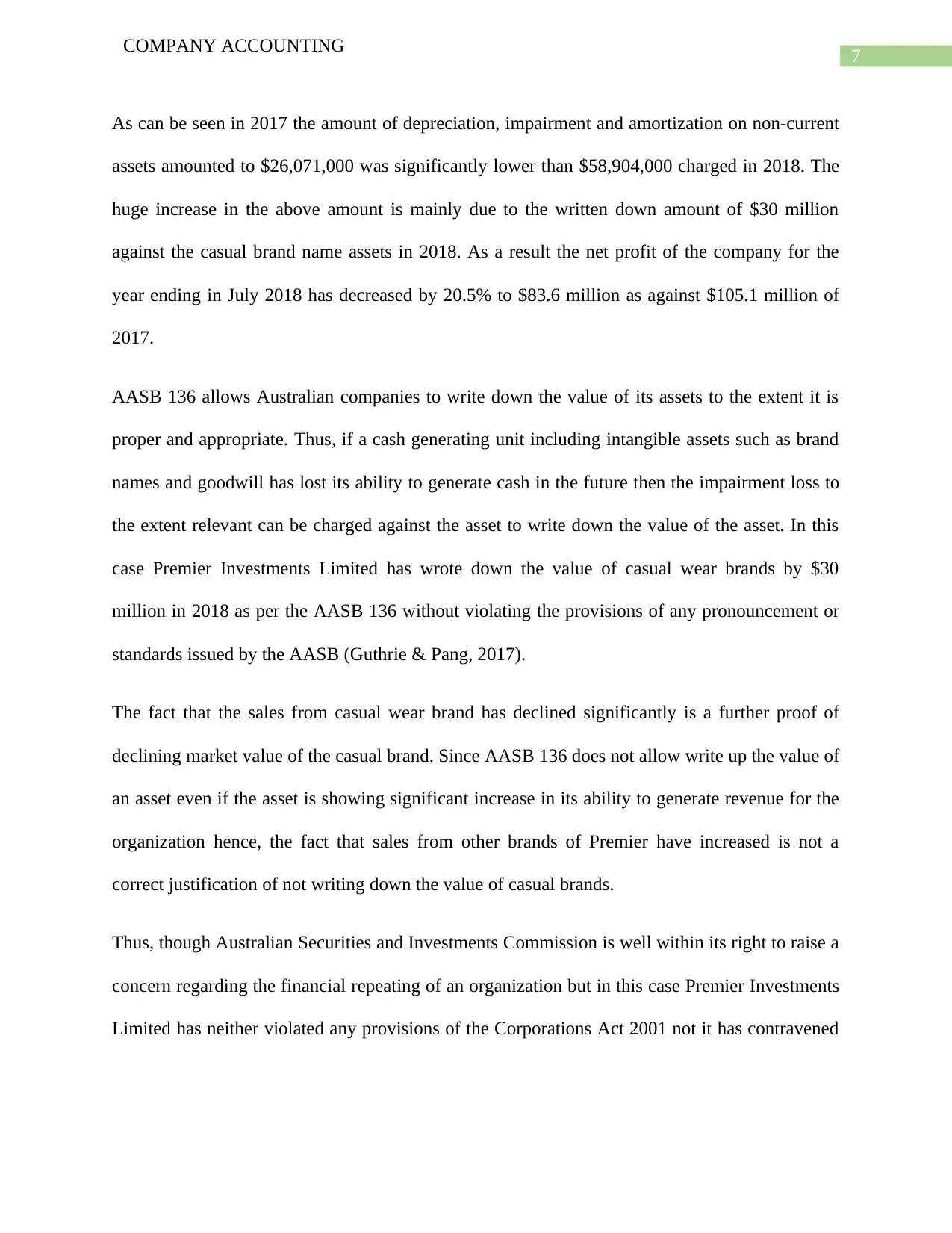
7
COMPANY ACCOUNTING
As can be seen in 2017 the amount of depreciation, impairment and amortization on non-current
assets amounted to $26,071,000 was significantly lower than $58,904,000 charged in 2018. The
huge increase in the above amount is mainly due to the written down amount of $30 million
against the casual brand name assets in 2018. As a result the net profit of the company for the
year ending in July 2018 has decreased by 20.5% to $83.6 million as against $105.1 million of
2017.
AASB 136 allows Australian companies to write down the value of its assets to the extent it is
proper and appropriate. Thus, if a cash generating unit including intangible assets such as brand
names and goodwill has lost its ability to generate cash in the future then the impairment loss to
the extent relevant can be charged against the asset to write down the value of the asset. In this
case Premier Investments Limited has wrote down the value of casual wear brands by $30
million in 2018 as per the AASB 136 without violating the provisions of any pronouncement or
standards issued by the AASB (Guthrie & Pang, 2017).
The fact that the sales from casual wear brand has declined significantly is a further proof of
declining market value of the casual brand. Since AASB 136 does not allow write up the value of
an asset even if the asset is showing significant increase in its ability to generate revenue for the
organization hence, the fact that sales from other brands of Premier have increased is not a
correct justification of not writing down the value of casual brands.
Thus, though Australian Securities and Investments Commission is well within its right to raise a
concern regarding the financial repeating of an organization but in this case Premier Investments
Limited has neither violated any provisions of the Corporations Act 2001 not it has contravened
COMPANY ACCOUNTING
As can be seen in 2017 the amount of depreciation, impairment and amortization on non-current
assets amounted to $26,071,000 was significantly lower than $58,904,000 charged in 2018. The
huge increase in the above amount is mainly due to the written down amount of $30 million
against the casual brand name assets in 2018. As a result the net profit of the company for the
year ending in July 2018 has decreased by 20.5% to $83.6 million as against $105.1 million of
2017.
AASB 136 allows Australian companies to write down the value of its assets to the extent it is
proper and appropriate. Thus, if a cash generating unit including intangible assets such as brand
names and goodwill has lost its ability to generate cash in the future then the impairment loss to
the extent relevant can be charged against the asset to write down the value of the asset. In this
case Premier Investments Limited has wrote down the value of casual wear brands by $30
million in 2018 as per the AASB 136 without violating the provisions of any pronouncement or
standards issued by the AASB (Guthrie & Pang, 2017).
The fact that the sales from casual wear brand has declined significantly is a further proof of
declining market value of the casual brand. Since AASB 136 does not allow write up the value of
an asset even if the asset is showing significant increase in its ability to generate revenue for the
organization hence, the fact that sales from other brands of Premier have increased is not a
correct justification of not writing down the value of casual brands.
Thus, though Australian Securities and Investments Commission is well within its right to raise a
concern regarding the financial repeating of an organization but in this case Premier Investments
Limited has neither violated any provisions of the Corporations Act 2001 not it has contravened
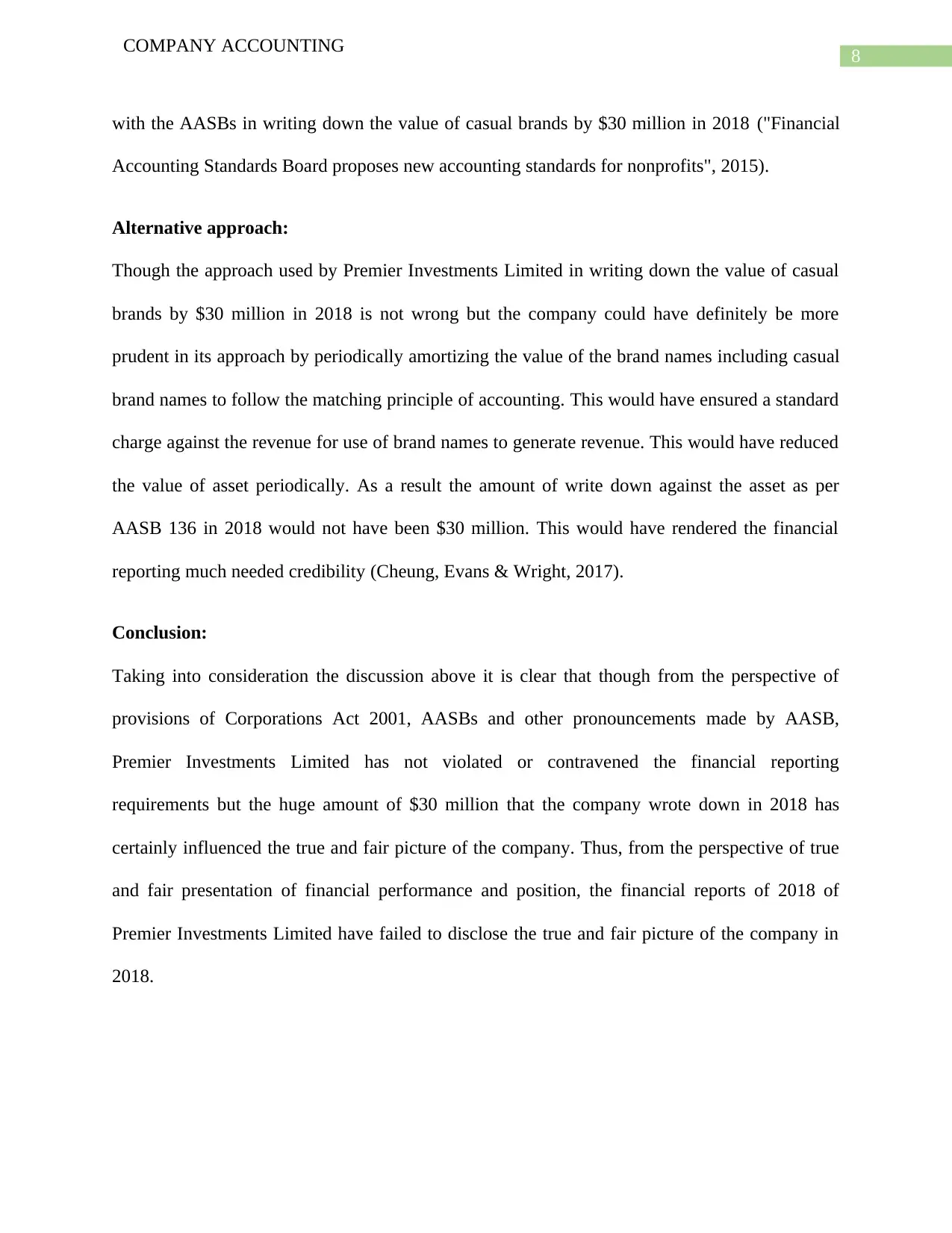
8
COMPANY ACCOUNTING
with the AASBs in writing down the value of casual brands by $30 million in 2018 ("Financial
Accounting Standards Board proposes new accounting standards for nonprofits", 2015).
Alternative approach:
Though the approach used by Premier Investments Limited in writing down the value of casual
brands by $30 million in 2018 is not wrong but the company could have definitely be more
prudent in its approach by periodically amortizing the value of the brand names including casual
brand names to follow the matching principle of accounting. This would have ensured a standard
charge against the revenue for use of brand names to generate revenue. This would have reduced
the value of asset periodically. As a result the amount of write down against the asset as per
AASB 136 in 2018 would not have been $30 million. This would have rendered the financial
reporting much needed credibility (Cheung, Evans & Wright, 2017).
Conclusion:
Taking into consideration the discussion above it is clear that though from the perspective of
provisions of Corporations Act 2001, AASBs and other pronouncements made by AASB,
Premier Investments Limited has not violated or contravened the financial reporting
requirements but the huge amount of $30 million that the company wrote down in 2018 has
certainly influenced the true and fair picture of the company. Thus, from the perspective of true
and fair presentation of financial performance and position, the financial reports of 2018 of
Premier Investments Limited have failed to disclose the true and fair picture of the company in
2018.
COMPANY ACCOUNTING
with the AASBs in writing down the value of casual brands by $30 million in 2018 ("Financial
Accounting Standards Board proposes new accounting standards for nonprofits", 2015).
Alternative approach:
Though the approach used by Premier Investments Limited in writing down the value of casual
brands by $30 million in 2018 is not wrong but the company could have definitely be more
prudent in its approach by periodically amortizing the value of the brand names including casual
brand names to follow the matching principle of accounting. This would have ensured a standard
charge against the revenue for use of brand names to generate revenue. This would have reduced
the value of asset periodically. As a result the amount of write down against the asset as per
AASB 136 in 2018 would not have been $30 million. This would have rendered the financial
reporting much needed credibility (Cheung, Evans & Wright, 2017).
Conclusion:
Taking into consideration the discussion above it is clear that though from the perspective of
provisions of Corporations Act 2001, AASBs and other pronouncements made by AASB,
Premier Investments Limited has not violated or contravened the financial reporting
requirements but the huge amount of $30 million that the company wrote down in 2018 has
certainly influenced the true and fair picture of the company. Thus, from the perspective of true
and fair presentation of financial performance and position, the financial reports of 2018 of
Premier Investments Limited have failed to disclose the true and fair picture of the company in
2018.
⊘ This is a preview!⊘
Do you want full access?
Subscribe today to unlock all pages.

Trusted by 1+ million students worldwide
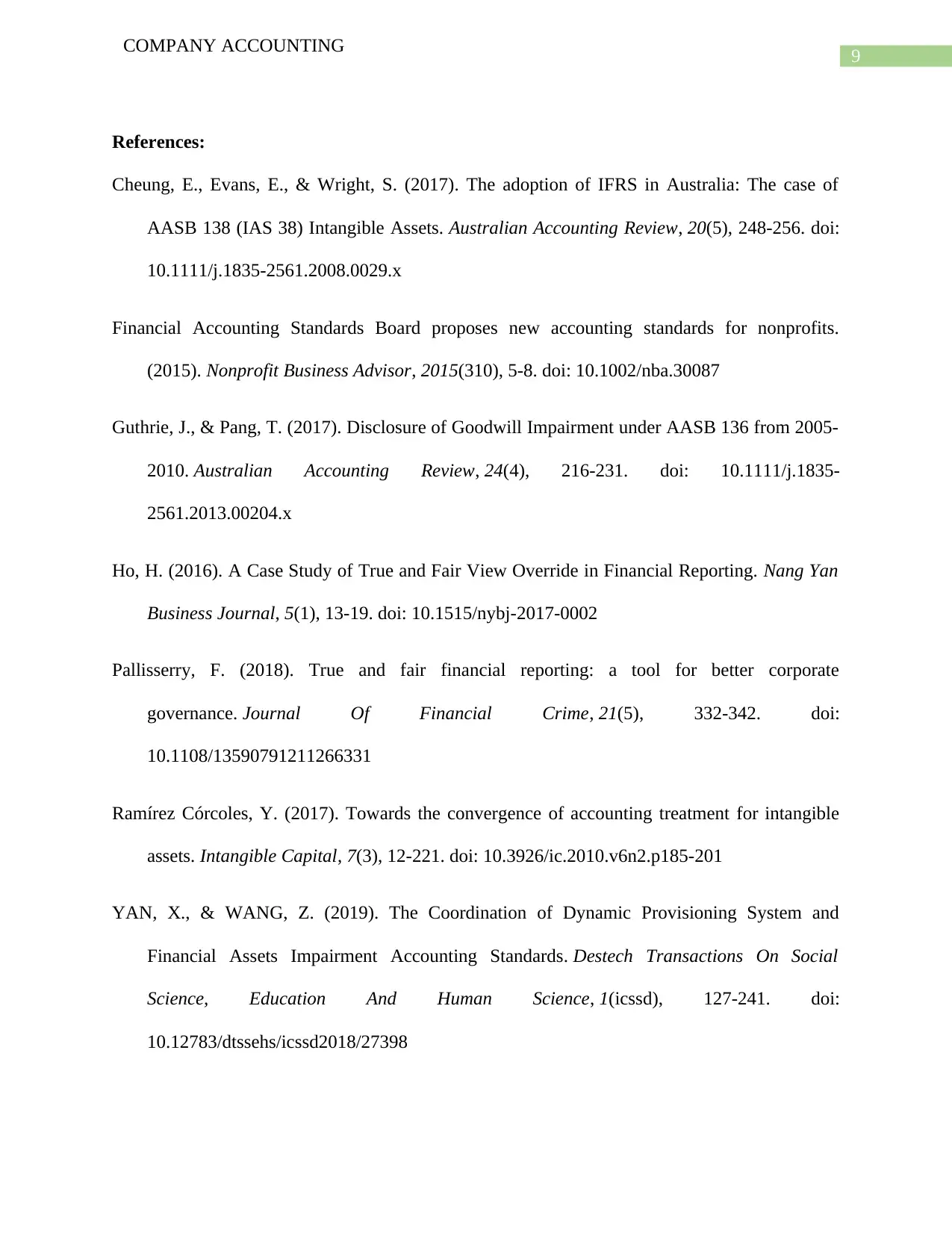
9
COMPANY ACCOUNTING
References:
Cheung, E., Evans, E., & Wright, S. (2017). The adoption of IFRS in Australia: The case of
AASB 138 (IAS 38) Intangible Assets. Australian Accounting Review, 20(5), 248-256. doi:
10.1111/j.1835-2561.2008.0029.x
Financial Accounting Standards Board proposes new accounting standards for nonprofits.
(2015). Nonprofit Business Advisor, 2015(310), 5-8. doi: 10.1002/nba.30087
Guthrie, J., & Pang, T. (2017). Disclosure of Goodwill Impairment under AASB 136 from 2005-
2010. Australian Accounting Review, 24(4), 216-231. doi: 10.1111/j.1835-
2561.2013.00204.x
Ho, H. (2016). A Case Study of True and Fair View Override in Financial Reporting. Nang Yan
Business Journal, 5(1), 13-19. doi: 10.1515/nybj-2017-0002
Pallisserry, F. (2018). True and fair financial reporting: a tool for better corporate
governance. Journal Of Financial Crime, 21(5), 332-342. doi:
10.1108/13590791211266331
Ramírez Córcoles, Y. (2017). Towards the convergence of accounting treatment for intangible
assets. Intangible Capital, 7(3), 12-221. doi: 10.3926/ic.2010.v6n2.p185-201
YAN, X., & WANG, Z. (2019). The Coordination of Dynamic Provisioning System and
Financial Assets Impairment Accounting Standards. Destech Transactions On Social
Science, Education And Human Science, 1(icssd), 127-241. doi:
10.12783/dtssehs/icssd2018/27398
COMPANY ACCOUNTING
References:
Cheung, E., Evans, E., & Wright, S. (2017). The adoption of IFRS in Australia: The case of
AASB 138 (IAS 38) Intangible Assets. Australian Accounting Review, 20(5), 248-256. doi:
10.1111/j.1835-2561.2008.0029.x
Financial Accounting Standards Board proposes new accounting standards for nonprofits.
(2015). Nonprofit Business Advisor, 2015(310), 5-8. doi: 10.1002/nba.30087
Guthrie, J., & Pang, T. (2017). Disclosure of Goodwill Impairment under AASB 136 from 2005-
2010. Australian Accounting Review, 24(4), 216-231. doi: 10.1111/j.1835-
2561.2013.00204.x
Ho, H. (2016). A Case Study of True and Fair View Override in Financial Reporting. Nang Yan
Business Journal, 5(1), 13-19. doi: 10.1515/nybj-2017-0002
Pallisserry, F. (2018). True and fair financial reporting: a tool for better corporate
governance. Journal Of Financial Crime, 21(5), 332-342. doi:
10.1108/13590791211266331
Ramírez Córcoles, Y. (2017). Towards the convergence of accounting treatment for intangible
assets. Intangible Capital, 7(3), 12-221. doi: 10.3926/ic.2010.v6n2.p185-201
YAN, X., & WANG, Z. (2019). The Coordination of Dynamic Provisioning System and
Financial Assets Impairment Accounting Standards. Destech Transactions On Social
Science, Education And Human Science, 1(icssd), 127-241. doi:
10.12783/dtssehs/icssd2018/27398
Paraphrase This Document
Need a fresh take? Get an instant paraphrase of this document with our AI Paraphraser

10
COMPANY ACCOUNTING
COMPANY ACCOUNTING
1 out of 11
Related Documents
Your All-in-One AI-Powered Toolkit for Academic Success.
+13062052269
info@desklib.com
Available 24*7 on WhatsApp / Email
![[object Object]](/_next/static/media/star-bottom.7253800d.svg)
Unlock your academic potential
Copyright © 2020–2025 A2Z Services. All Rights Reserved. Developed and managed by ZUCOL.




